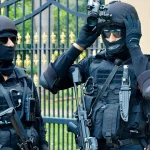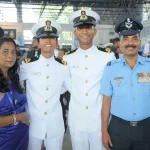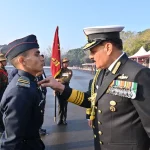The landscape of military service in India has evolved significantly, especially in recent years with respect to gender inclusion. Traditionally, roles in elite units such as MARCOS (Marine Commandos), a specialized unit of the Indian Navy, were reserved for male personnel. However, groundbreaking changes are underway that allow women not only to serve in the Navy but also to engage in special operations. This transformation marks a historic milestone, illustrating a commitment to breaking gender stereotypes and embracing a truly inclusive approach to defence.
The Indian Navy, heralded for its progressive stance, has opened the doors for women to join the ranks of MARCOS, enhancing the fighting force’s capabilities and embodying the spirit of gender equality. This decision not only empowers women but also strengthens the Navy’s operational edge by diversifying its ranks. As we delve deeper into this topic, we will explore the intricate pathways associated with joining MARCOS, the rigorous training regimes, and the broader implications of this inclusion.
Historical Context
MARCOS, formed in 1987, emerged in response to India’s need for a specialised naval force capable of handling a range of maritime missions, including counter-terrorism and reconnaissance. Initially, it was an all-male unit, formed to undertake tasks that required elite physical and psychological resilience, like combat diving and clandestine warfare. For decades, military combat roles remained predominantly male-dominated across the globe.
The inclusion of women into these domains began to gain momentum in the early 21st century, spurred by various socio-political movements and an evolving global perspective on gender roles in the military. In India, the court’s directive to allow women in combat roles in 2020 led to a wave of reforms, opening new avenues across all military branches. The introduction of the Agnipath scheme—an initiative launched in 2022 to recruit young personnel into the Armed Forces—played a pivotal role in promoting gender diversity. Under this scheme, women now have the opportunity to join the Indian Navy and, subsequently, volunteer for challenging roles within MARCOS.
Enrollment Path: Becoming an Agniveer
To embark on the journey towards becoming a MARCOS operative, women must first enlist in the Indian Navy as Agniveers. This recruitment is highly structured and selective, with the following key details:
- Eligibility Criteria:
- Indian citizenship is a prerequisite.
- Candidates aged approximately 18 to 30 years must have completed at least higher secondary education (10+2).
- Physical fitness and medical standards determine eligibility, ensuring candidates are at peak condition for demanding tasks ahead.
- Agniveers and Transitioning to MARCOS:
- Once enlisted, women undergo basic naval training before they are eligible to volunteer for MARCOS selection.
- Importantly, this process is voluntary; there is no direct assignment to MARCOS, ensuring that only those truly committed to these elite roles proceed.
Elite Training: The MARCOS Experience
The training regimen for MARCOS is among the toughest in the world, designed to push candidates to their physical and mental limits. Here’s what to expect:
Rigorous Training Modules
- Parachuting: Candidates undergo extensive skydiving training, fostering the skills needed for airborne operations.
- Combat Diving: Emphasis is placed on underwater diving techniques, with operatives often working in hostile marine environments.
- Special Operations: Trainees learn about covert engagements, reconnaissance missions, hostage rescues, and counter-terrorism methodologies.
Dropout Rates and Selection
The dropout rate for MARCOS training is astoundingly high, exceeding 80%. This statistic underscores the immense mental resilience and physical strength required to successfully complete the program. The selection process is not merely about fitness but also about the ability to work as part of a team under extreme pressure. Candidates can expect to face arduous challenges that test their commitment, adaptability, and tactical thinking.
Role and Capabilities of MARCOS
Once operational, women serving in MARCOS will undertake the same critical roles and challenges as their male counterparts. The capabilities expected from MARCOS operatives include:
- Covert Attacks: Engaging in stealthy operations to neutralize threats, often not limited to sea engagements.
- Underwater Operations: Conducting missions beneath the surface to gather intelligence or execute attacks.
- Reconnaissance: Gathering vital information regarding enemy positions and movements, crucial for formulating strategic responses.
- Counter-Terrorism: Engaging in direct action against terrorist threats, both on land and sea.
This capability set reinforces the notion that diversity can enhance operational effectiveness in high-stakes environments. Female personnel in MARCOS will bring unique perspectives and problem-solving approaches, ultimately contributing positively to mission outcomes.
The Significance of Inclusion
The policy change to include women in special forces like MARCOS is significant for several reasons:
- Historical Milestone: For the first time, female personnel in the Indian Armed Forces can serve in roles previously reserved for men, allowing for full participation in elite operational capacities.
- Cultural Shift: This move reflects a broader cultural shift within the Indian military towards inclusivity and equality. It signals an understanding that strength and capability are not defined by gender.
- Operational Effectiveness: Diverse teams have been shown to perform better, offering innovative solutions and enhancing decision-making processes. By leveraging both male and female perspectives, MARCOS can potentially improve its operational strategies.
Statistical Data and Research Insights
According to various reports and official sources, the Indian Navy has set up mechanisms to ensure the transition for women into MARCOS is smooth and equitable. Recent statistics illustrate a growing trend toward gender inclusivity in the armed forces:
- As of 2023, the Indian Navy has registered a notable increase in female personnel willing to join combat roles, indicating a shifting societal mindset.
- Comparative studies from other countries, such as the United States and Israel, showcase that women serving in elite military units have vastly enriched operational outcomes. Similar outcomes can be anticipated within the Indian context.
Challenges and Solutions
While the inclusion of women in MARCOS marks significant progress, several challenges persist:
- Physical Training Requirements: The intense physical demands of MARCOS training can pose challenges for female candidates. To address this, the Navy can develop specialized training programs that cater to enhancing physical strength and endurance among women.
- Cultural Barriers: Stereotypes and cultural perceptions regarding women in combat roles may affect recruitment. Awareness campaigns that highlight successful female role models within the armed forces can serve to inspire and motivate potential candidates.
- Balancing Family and Career: Many women face societal expectations regarding family responsibilities. The Navy could implement supportive measures, such as flexible schedules or family-related policies, to help women balance military duties and personal obligations.
Future Trends and Predictions
As the Indian Navy continues to modernize and embrace inclusivity, we can anticipate several emerging trends:
- Increased Recruitment: With the successful integration of women into roles previously held exclusively by men, recruitment numbers are expected to rise, fueled by enhanced visibility of female role models in the armed forces.
- Expansion of Roles: The Navy may explore further opportunities for women in operational capacities, potentially leading to a complete gender-neutral policy across all military branches.
- Enhanced Training Protocols: The development of specialized training programs to accommodate women and promote equality within the elite units, ensuring that all personnel meet the high standards set forth.
Conclusion
The decision to allow women to join MARCOS represents a seismic shift in the Indian military landscape. By paving the way for female operatives in elite special forces, the Indian Navy not only challenges longstanding stereotypes but also embraces a more comprehensive approach to national security. As we stand at this pivotal juncture, the commitment to gender equality within defence not only empowers women but also enriches the operational capabilities of the armed forces.
The call for more women to step forward, embrace rigorous training, and take up the mantle of responsibility in MARCOS and similar units is clear. The journey to inclusion has commenced, and it promises to enhance India’s defence posture while inspiring a new generation of women to serve their country with honor, courage, and integrity.
—
This marks the beginning of a new era for women in the Indian Armed Forces, one that underscores their capacity to excel in roles that require the highest levels of skill, resilience, and bravery. For aspiring candidates, resources such as SSBCrack and SSBCrackExams offer valuable insights and training materials that can aid in preparing for this remarkable journey.












